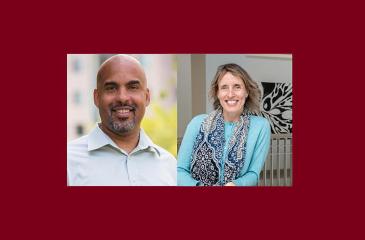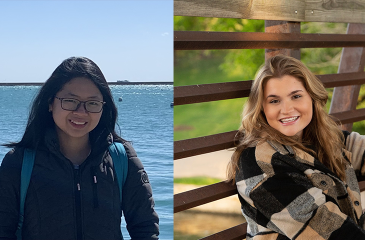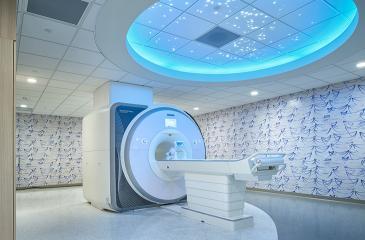Dr. Anita Randolph Produces Valuable Research and Builds Community Engagement
“My story is kind of strange, and it’s not as clear as others.”
Anita Randolph, PhD, an assistant professor in the Department of Pediatrics, took a very non-linear path to get to the University of Minnesota Medical School. Originally, Dr. Randolph wanted to conduct research on exotic animals, particularly big cats like cheetahs and tigers. This interest led her to be involved with a research program studying stroke in animals. The program fit her into its last remaining spot, which was focused on neuroscience.
“I had the opportunity to try different kinds of research and different kinds of specialties. At the time I said, ‘Gosh, this is so the opposite of what I wanted to do with my life,’ but the skills transferred,” Dr. Randolph said.
While studying at the University of Alabama - Birmingham, she began to hone in on what aspects of neuroscience she was most interested in. It turns out that it was all of them.
“I knew that it was the field I wanted to be in because, no matter where I got placed, I was still in love. It didn’t matter if I was working with Alzheimer’s disease or PTSD, as long as I was in the field learning, I was totally happy,” Dr. Randolph said.
Dr. Randolph’s different research opportunities, in addition to the time she spent away from home, confirmed her desire to work with children. She completed her dual PhD program at Shriners Hospital focusing on burn and smoke victims but didn’t even consider the connection to neuroscience when she applied. Over time, she realized that the role provided great research opportunities, and in 2018, Dr. Randolph was the lead author for a report on blood-brain barrier dysfunction after smoke inhalation injury, with and without skin burn. The work was showcased on the cover of the medical journal SHOCK due to its significance. Before the publication, there were very few existing reports that described neurological complications following smoke inhalation injury.
Dr. Randolph’s interests in neuroscience and working with adolescents were coming together well, but the amiable communication style she developed from her southern roots wasn’t being put to use. She knew that her past community activism work and homegrown communication skills could help advance scientific research, too.
“Once I got to UGA, I realized, ‘Woah, I really miss being out in the community and volunteering and doing different stuff.’ All of these years, I got a lot of experience organizing, experience with youth engagement, educational programs and creating training curriculum for communities. Then, when I started at Oregon Health and Science University, that’s when I met Damien Fair,” Dr. Randolph said.
The duo met at a conference in 2018. Damien Fair, PA-C, PhD, a professor in the Department of Pediatrics, now serves as co-director of the Masonic Institute for the Developing Brain (MIDB), an interdisciplinary collaboration that is dedicated to fostering healthy brain function in children across the lifespan. The two already had mutual scientific interests, and Dr. Randolph’s extensive experience with community engagement aligned with the research that Dr. Fair was hoping to accomplish.
“When I saw Dr. Fair present for the first time, it was so captivating because he talked about research, then right in the middle, he talked about community engagement, and then he kept right on with the rest of his presentation. I thought, ‘Wow, that’s so interesting.’ I had never in my life seen a researcher stop and talk about community engagement in the middle of their presentation. Sometimes, they don’t even talk about it at all, but he took time to say how important it was for him. Afterwards, I ran up to him and said, ‘I’m the student you’re supposed to meet, and we’re going to work together,’” Dr. Randolph said.
Fast forward a few years and Dr. Randolph is now the director of the Community Engagement and Education Core for the MIDB. She will continue to produce valuable scientific research and simultaneously represent the MIDB to local communities. Her comfortability within both realms is an asset to a research group that must manage a lot of moving parts to be successful.
“I did not think I’d be in the activism realm, but over the years – as I’ve been involved in community engagement – I’ve realized that a lot of the skills I’ve learned in my formal training can be useful to push a community’s agenda forward to ensure funding is accessible and that our work translates into policy changes that are tangible throughout the community. Wait to be invited into their space, ask what their needs and gaps are, how I can be useful to close those gaps as a partner, as well as where they want to see their community transition next,” Dr. Randolph said
The local Somali community knew Dr. Randolph from her previous work in Oregon, so they asked if she could help with an ongoing project. They had recently bought several buildings for children with autism spectrum disorder because they felt there weren’t any culturally-responsive clinics in the area. But, the facilities still needed staffing and training. Dr. Randolph acted as a liaison and reached out to all relevant contacts within the medical community to try and form a coalition that could consult the group throughout the process. This ensured they had resources to navigate the complexities of insurance and that they didn’t pay for training sessions, which could be costly and unnecessary.
Another ongoing project involves working with Native American and Somali communities to have English words displayed with an accompanying folk story, connecting it to their unique culture.
“This is important because I might know a word since I was born and raised here, but when I say it to somebody else at home, they may not understand. But, I know a story or example that I’ve heard a thousand times to describe emotions or even a neurodevelopmental disorder. We must make those bridges for people,” Dr. Randolph said.
Sometimes, Dr. Randolph simply connects different people who can help each other, but the importance of doing this to avoid miscommunication and to improve accessibility for local communities cannot be understated. The MIDB cannot produce quality research without quality research participants, and they cannot meet the needs of local communities without their honest feedback. Outreach and community engagement will continue to be central elements of the MIDB with Dr. Randolph at the helm.
This story was originally published by the University of Minnesota Medical School on Feb. 25, 2021.



